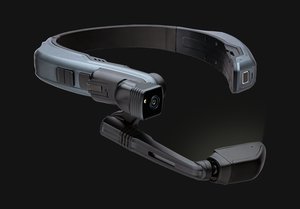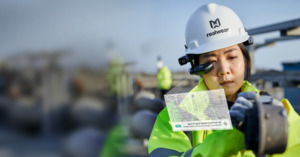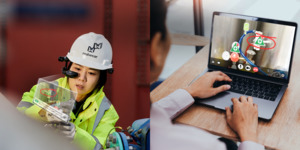
 |
Charlotte Stonestreet
Managing Editor |
| Home> | IIot & Smart Technology | >Industry 4.0 | >Future of the frontline |
Editor's Pick
Future of the frontline
08 August 2022
With trends such as digital transformation driving change, Jon Arnold looks at how the industrial workforce can stay safely connected and empowered with Augmented Reality (AR) tools

THE TRUTH is the industrial workforce is in a state of constant change. For better or for worse, this has gotten real, if you will, in the past few years. Certainly, a global pandemic played a role, but it was not the only force of change. Many trends such as an increase in digital transformation initiatives, were simply magnified, creating a perfect storm of needs looking for solutions.
Amid this, the needs of the frontline worker has been top of mind for IT, EHS, HR and business operations leaders. Keeping onsite experts offsite and working remotely using new digital tools like wearables was a novel idea and tested globally in order to reduce and mitigate the rapid spread of COVID-19. With the vaccines, that is less of a requirement today, but as a point of introspection and learning moment, many companies took the opportunity to better understand the ongoing value of a remote connected worker. They have now seen first-hand how collaboration tools like Zoom and Microsoft Teams quickly became the norm and are now routine tools used daily.
After their operations faced major challenges due to travel restrictions, companies invested in keeping workers – both frontline and otherwise – safely connected and empowered with Augmented Reality (AR) tools. Today, their investment remains valuable.
As workplace trends evolve, a clearer picture of the future of work for the frontline worker is taking shape. We anticipate more workers will be equipped with wearable devices like AR Head-Mounted Devices (HMDs), which can both access and capture data easily. This data and the use cases enabled become the norm under all circumstances – not just extreme ones – as companies see the potential of a near-permanently connected frontline workforce.
Extended Reality Spectrum
AR and Virtual Reality (VR) often get the spotlight as the next great leap in boosting worker productivity. But there are also emerging technologies such as assisted reality, that gives users hands-free access to the right information right when they need it. Not only does access to real-time information keep a business agile, it enables the user to maintain full situational awareness, which is critical if they are working in dangerous environments or near machines that pose a threat to life.
However, it's important to make and understand the distinction between AR and assisted reality. Assisted Reality is a ‘reality first, digital second’ experience. Assisted reality enables a person to view a screen with an immediate field of vision, hands-free. Information is not overlaid with the real-world view. Such is its value, customers are finding new and meaningful applications for it from retail all the way to on the top of wind turbines. Businesses are beginning to hear about its advantages, ranging from training and simulation all the way to leveraging assisted reality to aid workers in factories.
The rise in Industry 4.0 applications and Internet of Things (IoT) that integrate assisted reality will only serve to drive further adoption. The next wave of innovation and new use cases will occur with further advancements in cloud services, which will accelerate or complement organisations’ digital transformation plans.
Manufacturing sector
The wider manufacturing market saw some of the earliest adoption of AR headsets. AR fits perfectly as a user-facing touchpoint for the broader connected platforms many manufacturers are starting to adopt. The benefits delivered by AR include hands-free data access, increased efficiency and safety, reduced operational downtime, and a quick ROI.
Looking ahead, it is essential for the manufacturing industry to understand the technology available today and where it’s heading in order for it to form a long-term, strategic adoption plan. Technology, like AR and assisted reality, is already available on the frontline. This will help the industry attract and retain talent (even more important today, given the great resignation challenge) and, long term, put it on the path toward the metaverse. Given that in January 2022, the U.S. Bureau of Labor Statistics announced that 4.5 million Americans left their jobs in November - the highest level since the agency began tracking this data in 2000 - this is particularly important.
It’s certainly the right direction of travel, as Eric Abbruzzese, Research Director at ABI Research and a top AR analyst, suggests: ‘Total augmented reality revenue in manufacturing will reach US$25 Billion by 2027, spurred by digitisation efforts and high-value use cases like remote expertise.’
Abbruzzese lists three recommendations for manufacturing companies considering the deployment of AR wearables:
- Expand thinking beyond just a factory floor for AR implementations. For end-to-end operators, AR plays in logistics, design, and brick and mortar are also opportunities for AR enhancement. The factory floor offers the highest potential return thanks to complexity and high downtime costs.
- Identify your level of digital maturity, and where AR can integrate within that. There is value both in standalone and integrated AR solutions, and the existing level of digitisation is a good starting point for planning. AR can act as a catalyst for other digital systems as well, and be used to find digital strengths and weaknesses, while still delivering intended value (e.g., remote expertise).
- Prepare for high-value usage scenarios that are not always obvious. Multi-language for global operations is an excellent example. This can fall out naturally with matching worker languages, but can expand with translation. Translation can be post-capture for things like step logging, sometimes in real time, if hardware supports it. A high-quality voice-enabled solution paired with a translation- capable platform can provide translation end-to-end.
Use cases
We’re already seeing many use cases where companies within the manufacturing industry are accelerating their connected worker programs and deploying this technology at scale.
By way of example, Nemco, a solutions provider for the food industry in the Nordics, implemented HMDs for remote expertise, in response to the COVID-19 pandemic and the need to support frontline workers. The company expanded AR HMD usage to its customers as well, delivering up to 10x reduction in the overall cost for customer support. In some cases, AR HMDs were the only possible support solution for Nemco when travel was restricted and on-site.
A large consumer packaged goods company well known for their soft drinks is another such example. It leveraged its HMDs as part of a global worker enablement effort. The company has used the headsets for remote expertise and has seen the expected returns with reduced travel costs and downtime. In addition, the multi-national brand leveraged the devices as a tool for global hands-free collaboration that enabled training in a worker’s native language— something that’s not always guaranteed with on-site training.
The past five years have shown the value of AR for enterprises. Remote assistance, training, knowledge capture, and more have proven returns. Integrating these capabilities for frontline workers has showcased this powerfully and, as a result, companies are moving to increase adoption of HMDs.
Jon Arnold is VP of EMEA at RealWear
Key Points
- Assisted reality is a ‘reality first, digital second’ experience; it enables a person to view a screen with an immediate field of vision, hands-free
- The factory floor can offer the highest potential returns from augmented reality thanks to complexity and high downtime costs
- There is value both in standalone and integrated AR solution; the existing level of digitisation is a good starting point for planning
- What does maintenance mean for aerospace?
- 2024 promising for UK manufacturers looking to automate
- Take remote control of safety concerns
- Research discovers 106% increase in new malware
- Small tubes, big impact
- Pandemic sparks 72% ransomware growth
- Rail Europe
- Reducing noise on the factory floor
- Innovation through collaboration
- DTC or FOC - which is better?
- Industry 4.0 ready
- Intelligent interlocks
- The digital future has begun
- The smart future of manufacturing
- Partnership integrates freight & warehouse management
- When & where will Industry 4.0 actually happen?
- Education key to unlocking I4.0
- How well is your smart farm running?
- Digitalisation, automation & electrification
- Industry 4.0 guidance platform






















